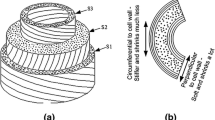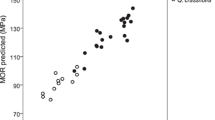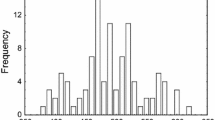Summary
This is a study on the shrinkage of wood representing the wide range of morphology variation in leaning trees. It involved 13 trees of Eucalyptus regnans, one of Eucalyptus sieberi and four of Pinus radiata, and specimens taken at close intervals around the circumference of each. Data indicated a systematic modulation, between extremes at upper and lower sides of each stem, in longitudinal growth strains, relative proportions of thin, medium and thick-walled fibres, microfibril angle in the S2 layer of these, and both Klason and acid-soluble lignin content. Analyses indicated that the microfibril angle in S2 was a prime factor in influencing both longitudinal and volumetric shrinkage reactions; proportion of thick-walled fibres in the tissue, thickness of S2 relative to S1, and variations in lignification also were involved. Unusually thick-walled fibres were associated with visco-elastic strain recovery effects, which could form a substantial part of dimensional changes apparently attributable to shrinkage.
Similar content being viewed by others
References
Barber, N. F. 1968. A theoretical model of shrinking wood. Holzforschung 22:97–103
Barber, N. F.; Meylan, B. A. 1964. The anisotropic shrinkage of wood. Holzforschung 18: 146–156
Bland, D. E.; Skicko, J.; Menshun, M. 1975. The relationship of acid insoluble lignin and acid soluble lignin to the lignins of the middle lamella and cell wall in E. regnans. Holzforschung 29:144–147
Bosshard, H. H. 1956. Über die Anisotropie der Holzschwindung. Holz Roh- Werkstoff. 14: 285–295
Boyd, J. D. 1950. Tree growth stresses. III. The origin of growth stresses. Aust. J. Sci. Res. B3: 294–309
Boyd, J. D. 1972. Tree growth stresses. V. Evidence of an origin in differentiation and lignification. Wood Sci. Technol. 6:251–262
Boyd, J. D. 1973a. Compression wood force generation and functional mechanics. N. Z. J. For. Sci. 3:240–258
Boyd, J. D. 1973b. Helical fissures in compression wood cells. Causative factors and mechanics of development. Wood Sci. Technol. 7:92–111
Boyd, J. D. 1974. Anisotropic shrinkage of wood; identification of the dominant determinants. J. Japan Wood Res. Soc. 20:473–482
Boyd, J. D.; Foster, R. C. 1974. Tracheid anatomy changes as responses to changing structural requirements of the tree. Wood Sci. Technol. 8:91–105
Boyd, J. D.; Schuster, K. B. 1972. Tree growth stresses. IV. Visco-elastic strain recovery. Wood Sci. Technol. 6:95–120
Cave, I. D. 1972. A theory on the shrinkage of wood. Wood Sci. Technol. 6:284–292
Freudenberg, K. 1964. The formation of the lignin in the tissue and in vitro. In: M. H. Zimmermann (Ed.): The formation of wood in forest trees, Academic Press, N.Y. pp. 203–218
Gaby, L. I. 1971. Longitudinal shrinkage and fibril angle variation in corewood of southern pine. Georgia For. Res. Paper No. 70, Georgia For. Res. Council, Marcon, Georgia
Isebrands, J. G.; Parham, R. A. 1974. Slip planes and minute compression failures in kraft pulp from Populus tension wood. Int. Ass. Wood Anat. Bull. 1974 (2): 16–23
Manwiller, F. G. 1967. Tension wood anatomy of silver maple. Forest Prod. J. 17 (1): 43–48
Meylan, B. A. 1968. Cause of high longitudinal shrinkage in wood. Forest Prod. J. 18 (4): 75–78
Nicholson, J. E. 1971. A rapid method for estimating longitudinal growth stresses in logs. Wood Sci. Technol. 5: 40–48
Nicholson, J. E.; Barnacle, J. E.; Lesse, P. F. 1973. Evidence of residual stress in small sections of ordinary green Eucalyptus regnans. Wood Sci. Technol. 7: 20–28
Nicholson, J. E.; Ditchburne, N. 1973. Shrinkage prediction based on an analysis of three wood properties. Wood Sci. 6: 188–189
Nicholson, J. E.; Hillis, W. E.; Ditchburne, N. 1975. Some tree growth-wood property relationships of eucalyptus. Canad. J. For. Res. 5: 424–432
Norberg, H.; Meier, H. 1966. Physical and chemical properties of the gelatinous layer in tension wood fibres of aspen (Populus tremula L.). Holzforschung 20: 174–178
Perkitny, T.; Helińska, L. 1961. Über den Einfluß gleichzeitiger Temperatur- und Feuchtigkeitsänderung auf die Verformungen des Holzes. Holz Roh- Werkstoff. 19: 259–269
Perkitny, T.; Helińska-Raczkowska, L. 1966. Über den Einfluß von Wachstumsspannungen auf die durch Temperatur- und Feuchtigkeitsänderung ausgelösten Verformungen des Holzes. Holz Roh- Werkstoff. 24: 481–486
Sachsse, H. 1965. Untersuchungen über Eigenschaften und Funktionsweise des Zugholzes der Laubbäume. Georg-August-Universität, Göttingen, Forstliche Fakultät. Schriftenreihe No. 35
Shelbourne, C. J. A.; Namkoong, G. 1966. Photogrammetric technique for measuring bole. 8th Southern Conf. on For. Tree Impr. Proc: 131–136
Wardrop, A. B.; Dadswell, H. E. 1955. The nature of reaction wood. IV. Variations in cell wall organization in tension wood. Aust. J. Bot. 3:177–189
Author information
Authors and Affiliations
Additional information
Relevant to 10 of the E. regnans trees in this study, appreciation is expressed to three colleagues for providing access to the detailed data on strain, cell wall thickness, and volumetric shrinkage involved in their published study [Nicholson, J. E., Hillis, W. E., and Ditchburne, N. 1975]. By prior arrangement to minimize duplication of effort, their data were derived from specimens from those trees that were involved in this study.
Rights and permissions
About this article
Cite this article
Boyd, J.D. Relationship between fibre morphology and shrinkage of wood. Wood Sci. Technol. 11, 3–22 (1977). https://doi.org/10.1007/BF00353597
Received:
Issue Date:
DOI: https://doi.org/10.1007/BF00353597




